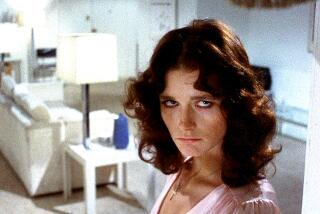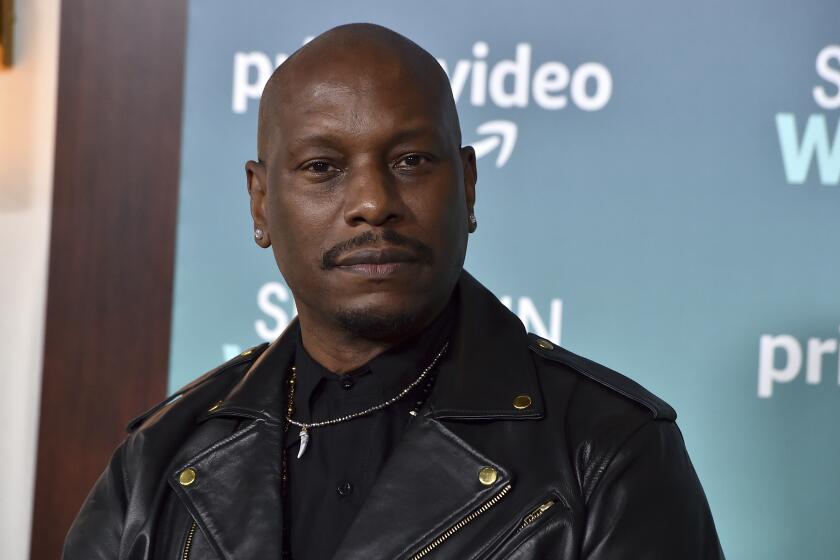THE MOVIES : THE RETURN OF ‘KILLER SUMMER’
If you care to relive, or experience for the first time, the movie summer of 1989--and you should , because it was one of the better summers--you can now rent from the video marts virtually all of the best and most popular films of that period.
Summertime used to be the ghetto for gizmo flicks and bonehead entertainments for the schooled-out crowd. Films of “serious” substance were considered too strenuous for the heat-stroked peewees flocking to theaters for reasons no more exalted than the air-conditioning and the Frosties.
But things have changed somewhat over the years, and the results have never been more apparent than they were this past summer. Whatever their merits, films like “Dead Poets Society,” “Casualties of War,” “Do the Right Thing” and “sex, lies and videotape” were not works of airheaded innocuousness. As the average age of filmgoers is again pointing toward adulthood--folks in their teens and early 20s no longer make up virtually the entire movie-going population--adult themes of more than passing controversy are being filmed. The controversies--such as race relations, Vietnam and parenting--are not always treated with any more depth than the teen-pix fluff they’re supplanting, but at least now you don’t automatically expect to spend your movie-going summer dodging UFOs and food fights.
Even last summer’s biggest hit, “Batman,” can lay claim to being more than a standard comic-book super-hero romp. It’s a brackish, subterranean mystery-fantasy with production design that’s a lot closer to Wagnerian opera or a Fritz Lang epic than to anything you might have seen on the airwaves starring Adam West. This is frivolity of a very weighty sort.
The opening-up of serious themes for summer is a wonderful development, since it means that there is now a greater number of opportunities to exhibit these films, and therefore more opportunities for their financing. And with the advent of video, there is also more chance of catching up with or re-seeing them. This is particularly important with films that didn’t get a fair shake on their initial release.
If, for example, you missed last summer’s “Vampire’s Kiss,” and most people did, you missed one of the most hair-raisingly original films of the year. It’s on video, though. Virtually all of the summer crop is, with the significant exception of Bruce Weber’s extraordinary Chet Baker documentary, “Let’s Get Lost,” and that one will eventually hit the video bins.
Just about any movie worth its salt (or its celluloid) is worth seeing on a big screen with big sound. But if you have no other choice, video is an attractive court of last resort. Here’s an alphabetical anthology of summer ’89 highlights.
“THE ABYSS”
This represents James (“The Terminator,” “Aliens”) Cameron’s attempt to locate a few pristine air bubbles in the primeval murk. Set mostly underwater, in the Cayman Trough in the Bahamas, the movie is like Nietzsche with the bends--until Cameron starts in with his wonder-of-it-all stuff, derived from “2001” and all those other movies where protoplasmic figurines shimmy their transcendance unto the millennium. “The Abyss,” which stars Ed Harris and Mary Elizabeth Mastrantonio, looks like the work of an action director who has found religion.
“BATMAN”
The voluptuously dark and oppressive swank of this infernal Tim Burton epic doesn’t register successfully on the small screen. That didn’t prevent it from becoming a blockbuster video hit last winter to match its summer theatrical success. As Batman, Michael Keaton is imposingly glum; Jack Nicholson’s Joker is the emblem of comic-book malevolence. As impressive as much of this movie is, I’m still not sure why it’s one of the most popular movies ever made. Maybe it’s because the filmmakers have, in Keaton’s Batman, come up with at least the outline of a hero for our distressed times--the good psychotic.
“CASUALTIES OF WAR”
Forget “Born on the Fourth of July.” The best Vietnam film of 1989--the best film of the year, for that matter--was Brian De Palma’s much-maligned “Casualties of War.” It’s based on the true story of an Army soldier (Michael J. Fox) who reports to his superiors the rape and murder of a Vietnamese girl (Thuy Thu Le) instigated by his platoon sergeant (Sean Penn). The film enfolds the Vietnamese in the war’s tragedy, it gives them a human face, and this may be a first in our films. “Casualties of War” has the brutal, edged power of the best war movies, and it has something even rarer: a feeling for war’s spiritual dread. De Palma didn’t just make another Vietnam film. He’s given us a new view of the pumping heart of darkness.
“DEAD POETS SOCIETY”
As an inspiring English teacher in a Vermont boys’ prep school circa 1959, Robin Williams gives his best and most finely understated performance to date. Otherwise, the film is a slickly engineered piece of sentimental muck about how art makes you, uh, a better person.
“DO THE RIGHT THING”
Spike Lee’s incendiary film about black-white relations in Brooklyn’s Bedford-Stuyvesant on the hottest day of the summer doesn’t look or sound like any other film. It’s about how racism makes you crazy. The film, which stars Lee and Danny Aiello, has its share of opportunism and cant, but there’s more excitement in what’s wrong with “Do the Right Thing” than in what’s right about most of the new movies. It’s the first major studio movie I’ve seen to plug into the resurgent anger and pride of a new and largely unrepresented-in-the-movies generation of blacks--those who identify strongly with Malcolm X.
“GHOSTBUSTERS II”
This sequel is basically a riff on the jokes and characterizations from “Ghostbusters.” It’s milder and smaller-scaled than that film, but it has its moments: Bill Murray’s jags, a great special effect involving the Statue of Liberty clomping Godzillalike through the streets of Manhattan, a moony confab between Rick Moranis and Annie Potts and a few throwaways involving Peter MacNicol as a funny-foreign-accented art restorer.
“HONEY I SHRUNK THE KIDS”
This kids’-stuff confection from Disney was a big hit with children. Adults kind of liked it, too. It has less than the usual dosage of Disney corn, and some of the dialogue is actually witty. Rick Moranis is the nut-brain inventor who accidentally shrinks to flea-size his two children and his neighbor’s brood, too. The film is best when it plays off our delight in the pleasures (and terrors) of becoming microscopic, a familiar theme in many of the best children’s fantasies. On the same tape is the hyperactive Roger Rabbit cartoon “Tummy Trouble.”
“INDIANA JONES AND THE LAST CRUSADE”
Steven Spielberg’s third installment in the Indiana Jones series doesn’t have the spring of his best work, and I’m not sure we need to see Harrison Ford wading yet again through viper pits as he battles Nazi meanies. Still, it’s a pleasant enough boy’s-book yarn, sweetly tempered, and as Indy’s father, Sean Connery is delightfully robust.
“LETHAL WEAPON 2”
This Mel Gibson-Danny Glover sequel starts out as a whiz-bang romp--closer to the “Roadrunner” cartoons, perhaps, than to “Lethal Weapon.” Then the explosions and the beatings start piling up, and we’re treated to such delicacies as Mel Gibson rolling around in pain with a knife stuck in his thigh. Joe Pesci, as a finicky fink, steals the movie.
“LICENCE TO KILL”
Timothy Dalton’s second go-round as OO7 is medium-grade Bond high jinks, no better or worse than most in the series. Now that the movies are relatively earthbound--no more intergalactic super-heroes and space-age duke-outs--the films seem rather tame. Steven Spielberg and his many imitators have already co-opted many of the Bond trademarks. Without the mock-imperialist trappings of the early Bond movies or the one-woman-per-quarter-hour sex parade, the current Bond cycle has had to fall back on standard-issue heroics and stunt work.
“PARENTHOOD”
“Parenthood” is a baby-boom “Hellzapoppin.” This comedy-drama about four families raising kids manages to pack in enough subplots to outfit 12 other movies. About three of them are good. The funny sequences are easily the most successful; when the “life lessons” start piling up, you feel gypped. Best reason to rent is for Steve Martin and Mary Steenburgen, playing the parents of a disturbed 8-year-old; and for Dianne Wiest’s performance.
“SEX, LIES, AND VIDEOTAPE”
This yuppie comedy of manners isn’t as good as the initial hoopla might have led you to believe. On video, its small victories actually come across better than in the theaters. The quartet of performers--James Spader, Andie MacDowell, Peter Gallagher and Laura San Giacomo--work extremely well together, and writer-director Steven Soderbergh’s conceits about, well, sex, lies and videotape, are engaging.
“STAR TREK V: THE FINAL FRONTIER”
I am not now nor have I ever been a Trekkie. The arcana of warp speeds, Klingons, Neutral Zones and Vulcan ears have never gotten to me. My connection to the “Star Trek” series is one of affection rather than obsession, which means that, so far as I can see, this latest episode is consistently enjoyable without ever lifting off into the higher realms of inspiration.
“VAMPIRE’S KISS”
Greatly neglected upon its release, this comic horror movie is alarmingly suggestive in ways that suggest David Lynch and German Expressionist fantasias. Nicolas Cage’s performance as the New York literary agent who believes he’s becoming a vampire is one of the most successfully over-the-top performances I’ve ever seen. Robert Bierman, a young Britisher, directed the smashing script by Joseph Minion, who wrote Martin Scorsese’s “After Hours”--a film with a similar urban creepiness. For the faint of heart, be forewarned: Cage actually eats a bug in this movie!
“WHEN HARRY MET SALLY”
Rob Reiner’s comedy, scripted by Nora Ephron, is charming and smart and quite disposable. It’s a supremely inoffensive comedy about two mismatched friends, played by Meg Ryan and Billy Crystal, who become lovers. All the right Woody Allen buttons are pushed: It’s hip to Manhattan yuppie mores; all the right watering holes and bookstores and neighborhoods are deified. But the over-familiarity is grating: It’s “Manhattan” Lite.
More to Read
Only good movies
Get the Indie Focus newsletter, Mark Olsen's weekly guide to the world of cinema.
You may occasionally receive promotional content from the Los Angeles Times.










